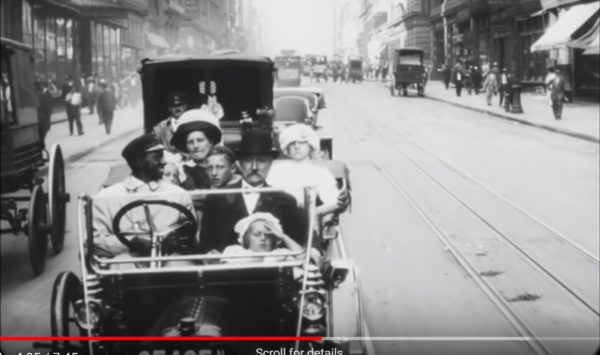HOW A CENSUS-TAKER SAVED OUR BLOCK (1900)
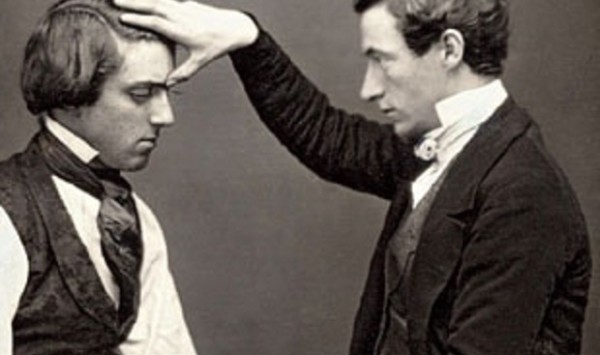
******************************************************************************************************************************** Brownstone Detectives investigates the history of our clients’ homes. The story you are about to read was composed from research conducted in the course of one of those investigations. Do you know the history of YOUR house? ******************************************************************************************************************************** I can tell you a little bit about every single family on my block. Well, not the present day families, of course – that might be a little creepy. Actually, it is a lot easier to extract such personal information about the families that lived on my block more than 100 years ago – in the year 1900. No, I am not a mesmerist or paranormal investigator. I don’t read cards or tea leaves. Nor do I make tables float or ask the spirit guides to knock in answer to my questions. I happen to use a less fantastic, more pedestrian source for this type of information for my answers. For, you see, I am a Brownstone Detective – and I use the 1900 Federal Census. I’M FROM THE FEDERAL GOVERNMENT AND I’M HERE TO HELP. The founders of our Federal government in the 18th century demanded that a decennial census be instituted. The demand was delineated within the U.S. Constitution, and the first attempt at listing Americans took place in 1790. The State of New York decided, too, that knowing who lived within its political boundaries was important. And so the state also began taking its own census in 1825. It was a decennial census, as well, which, in order […]
COL. BACON KISSED THE WIVES (1905)

It is a shame the way newspaper reporters don’t write these days. The folksy, tongue-in-cheek, gossipy style of 100 years ago would today seem too daring, too familiar. And perhaps newspapers now are just a little too gun-shy of potential libel suits… Here is a story reported by the Brooklyn Daily Eagle in 1905, that combines all the elements of a ribald over-the-fence tittle-tattle: Brooklyn Daily Eagle, Fri., 20 October 1905 — The home makers and home defenders of Prospect Park South were stirred this morning to dark purposes. Quite well it was that Colonel Alexander S. Bacon got away from Ditmas Park home in that aristocratic section before his neighbors saw the morning papers in which the gallant colonel was depicted in the very act of kissing their wives. Not only that, but the same papers had Colonel Bacon declaring publicly that he had been enjoying sweet osculatory favors. It all grew out of Colonel Bacon’s law business. He was defending Mrs. Hortense Powers from the suit of her husband, William F. Powers, who wanted a divorce on the ground that Mrs. Powers had been too free with her kisses and favors for a neighbor, “Billy” Campbell. Colonel Bacon tried to excuse and justify these little tokens of affection. Here is the argument he was reported to have used before the jury: “Gentlemen, every one of you who is married probably has kissed his neighbor’s wife. Without wishing to be egotistical, I might say that I have been fortunate […]
THE MISSING CORNERS OF BED-STUY (1941)
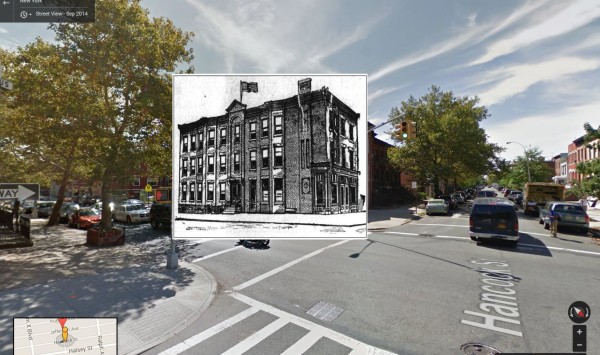
******************************************************************************************************************************** Brownstone Detectives investigates the history of our clients’ homes. The story you are about to read was composed from research conducted in the course of one of those investigations. Do you know the history of YOUR house? ******************************************************************************************************************************** So many of our corner buildings are missing. If you walk around any neighborhood that was built-up in the late 19th/early 20th century, you’ll find that many of these “end-lot” buildings did not survive the “down” periods of Brooklyn history. Compared to their smaller 1- and 2-family homes that have historically surrounded them, these larger apartment buildings have had a much more difficult time staying maintained and holding on to their tenants. Largely due to costs, the maintenance and upkeep has gone first, followed by the disappearance of the tenants – then the buildings themselves. Many of these buildings have been torn down, actually, since the 1980s – some as recently as 7-10 years ago. Sadly, we even see “tear-down” candidates which have surprisingly lasted into the present century – those buildings which, to a builder, would be cheaper to tear down than to renovate. If you want to see what these old “disappeared” apartment buildings look like, there is a deteriorating example that sits today at the corner of Malcolm X Boulevard and Macon Street. This one is already on the auction block and, sadly, will struggle to survive into the next decade. THE LOTS OF BED-STUY One Brooklyn neighborhood where empty corner lots abound is Bedford-Stuyvesant. These lots tell […]
SPRING, DAY 1, “TAKING OF PARTNERS” (1905)
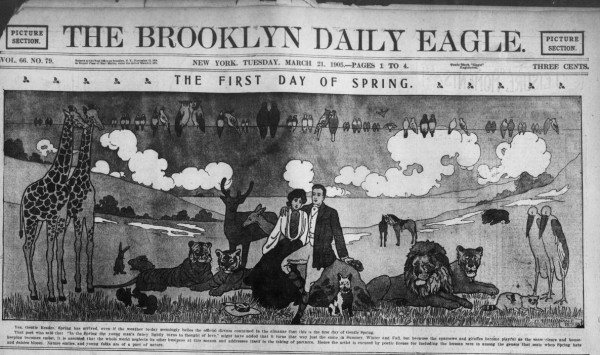
******************************************************************************************************************************** Brownstone Detectives investigates the history of our clients’ homes. The story you are about to read was composed from research conducted in the course of one of those investigations. Do you know the history of YOUR house? ******************************************************************************************************************************** As the snow begins to melt and migrating birds begin to reappear upon the southern horizon, newspaper journalists have historically been excused if they turned to dreaminess and began to write in the style of Byron. “Yes, Gentle Reader,” cooed the Brooklyn Daily Eagle in its “First Day of Spring” edition of 1905, “Spring has arrived, even if the weather to-day seemingly belies the official dictum contained in the almanac that this is the first day of Gentle Spring.” (Wha-wha-whaaaaaaaaaaat???) “That poet who said that ‘In the Spring the young man’s fancy lightly turns to thoughts of love,’ might have added that it turns that way just the same in Summer, Winter and Fall, but because the sparrows and giraffes become playful as the snow clears and house-keeping becomes easier, it is assumed that the whole world neglects its other business at this season and addresses itself in the taking of partners.” (emmmmmm…..giraffes and…..ummmm……snow….?) “Hence the artist is excused by poetic license for including the human race in among the genus that mate when Spring hats and daisies bloom.” (Spring hats and….mating? okaayyyyyyyyyyyyyy….) “Nature smiles and young folks are of a part of nature.” Don’t take this stuff too seriously, folks. Just enjoy the 1st days of Spring – if you […]
WHEN WOOD HOUSES BECAME EXTINCT (1909)
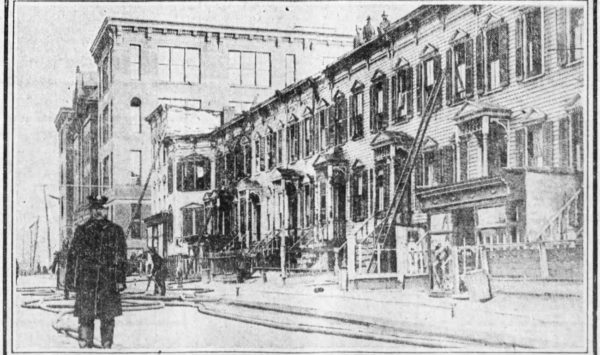
******************************************************************************************************************************** Brownstone Detectives investigates the history of our clients’ homes. The story you are about to read was composed from research conducted in the course of one of those investigations. Do you know the history of YOUR house? ******************************************************************************************************************************** On a cold December day in 1909, on a busy thoroughfare in Brownsville, the lives of hundreds of school children were invariably altered when a row of frame houses adjoining their school began to burn out of control. The flames “shot to the roof and then ran under the cockloft roof of ten two-story frame structures.” “Fanned by high wind, the smoke from the burning structures enveloped the schoolhouse,” noted the Brooklyn Daily Eagle. The school, which no longer exists, sat at one time on the corner of Dumont Avenue and Powell Street – where the Van Dyke II Senior Center now exists. The smoke enveloping P.S. 109, as the school was known, which had “accommodations for five thousand pupils,” had brought their “excited parents” by the dozens who “refused to believe at first that flames were not raging in the building.” “So quickly did the fire eat away through the row of frame houses that many of the inmates had narrow escapes.” That day, the city condemned at least 10 two-family houses which were housing approximately 25 families, making roughly 150 residents instantaneously homeless. EXTENDING THE FIRE LIMITS Advocates for the termination of the building of wood frame houses increased their pleas to city officials to extend the fire limits […]
THE KEEPING OF BROWNSTONES – 1, 2, 3 (1909)
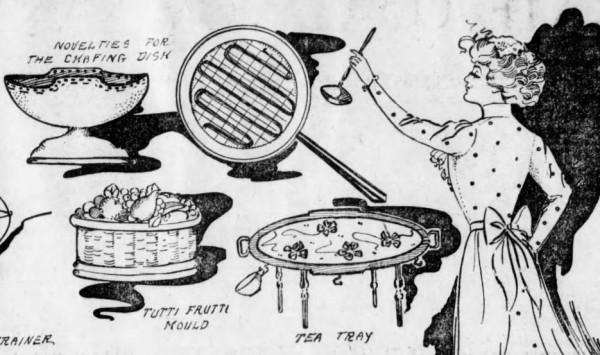
******************************************************************************************************************************** Brownstone Detectives investigates the history of our clients’ homes. The story you are about to read was composed from research conducted in the course of one of those investigations. Do you know the history of YOUR house? ******************************************************************************************************************************** Every year new wonders are invented that will make housekeeping a pleasant occupation for the housewife. So declared the Brooklyn Daily Eagle in the 3 October 1909 edition of their paper in a “puff” piece on the latest in kitchen tools for the good housewife. The article slyly implied that women’s housework was difficult and so why not make it easier on her by purchasing the latest in kitchen gadgets. SELLING THE LATEST IN KITCHEN GADGETS These type puff articles were mostly fillers in the newspaper, but they also spoke to the housewife who was more often reading newspapers and sought out improvements in the tools she used in keeping house. (On the same page were articles entitled, “Artist or Woman,” “Women of Iceland Lead Active Lives,” and “The Making of Perfume.” Newspapers must have known what women wanted to read about back then!) This piece presented some of the newer tools available in the market – many of them simply improvements on older ones – that made life in the kitchen simpler. “The housewife who is dissatisfied with her present equipment…will not find it much of a task to secure new things,” the reporter informed. The correspondent then went on to lay out and describe the “newest production in metal […]
TIMEWARP TUESDAY! DEAN ST. (1905 v. 2014)
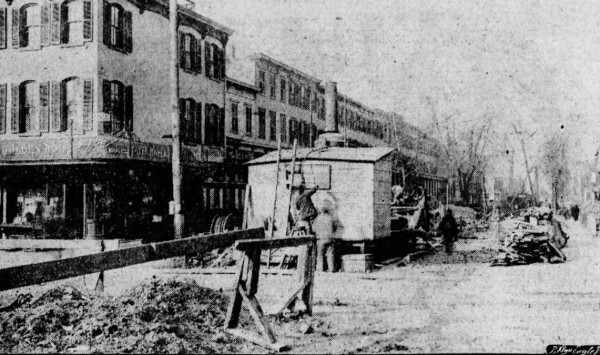
******************************************************************************************************************************** Brownstone Detectives investigates the history of our clients’ homes. The story you are about to read was composed from research conducted in the course of one of those investigations. Do you know the history of YOUR house? ******************************************************************************************************************************** Back in late 1904/early 1905, people living on Dean Street, from Third to Fifth avenues, and on Fifth Avenue, from Dean Street to Flatbush Avenue, were “complaining bitterly of the condition of the streets, which have been torn up for a number of months. “The sidewalks are covered with dirt and rubbish and traffic is delayed seriously.” Pictured is the intersection at Dean Street and 4th Avenue – in 1905 and in 2014. Can you spot the differences between the two pictures? Follow @BrownstoneDetec Share ———————————————————————————————————————– The Brownstone Detectives Brownstone Detectives is an historic property research agency. Our mission is to document and save the histories of our clients’ homes. From our research, we produce our celebrated House History Books and House History Reports. Contact us today to begin discovering the history of your home.
THE LURE OF A FEDDERS HOUSE (1902)
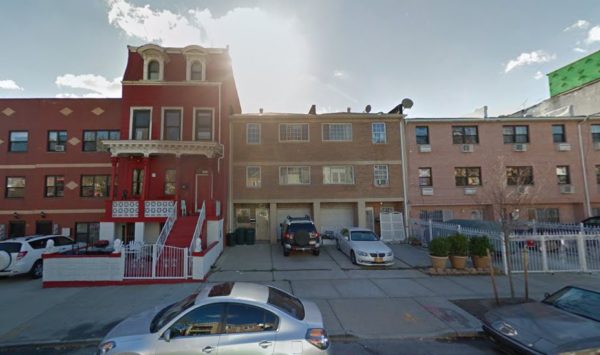
******************************************************************************************************************************** Brownstone Detectives investigates the history of our clients’ homes. The story you are about to read was composed from research conducted in the course of one of those investigations. Do you know the history of YOUR house? ******************************************************************************************************************************** (In 1868, Quincy Street [between Bedford and Nostrand avenues] boasted of rows of beautiful Victorian wood-frame homes. The row pictured above contained houses like the red building above.) In 1902, luxurious wood frame houses that had been built closer to the middle of the century before were beginning to show their wear – not just in their physical appearances, but also within the rental rolls that such structures had previously been able to command. Since 1868, when the above house (third from left) was built, brownstone and limestone fronted houses had come into vogue, attracting those with means to buy and rent them, while forcing owners of the antiquated frame houses, due to the old issue of supply and demand, to reduce their rents – significantly. “There is a row of three story frame houses on Quincy street, between Bedford and Nostrand avenues which illustrates the demand for houses with a modern style of front,” noted the Brooklyn Daily Eagle. “The Quincy street houses were built in 1868 by a well known architect and builder. They are 20 feet wide on an extra deep lot. The accompanying picture shows the appearance of the houses (no photograph was actually printed with this article). They sold for $9,000 each upon completion. Those who […]
HOW TO ABANDON A BROWNSTONE (1907)
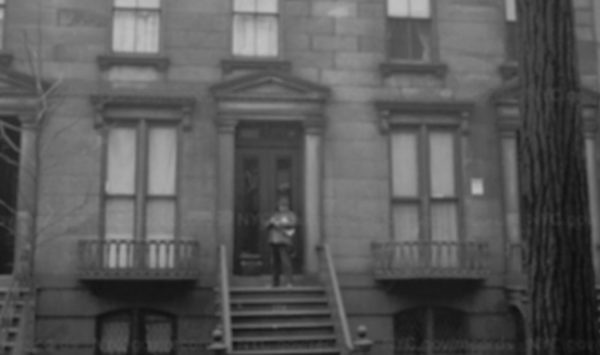
******************************************************************************************************************************** Brownstone Detectives investigates the history of our clients’ homes. The story you are about to read was composed from research conducted in the course of one of those investigations. Do you know the history of YOUR house? ******************************************************************************************************************************** The house at No. 178 State Street in Brooklyn Heights once sat untouched for almost 20 years. Owned by a woman in a sanitarium who was unable to utilize the property, she made all of her heirs promise – in 1889 – never to enter the house until she was dead. Apparently, though, they kept up appearances well in her absence by putting “help wanted” notices in the paper, and advertising “furnished rooms” in the house. The woman in question, Mrs. Mary J. Cooke King, according to her obituary, had been a leader during the Civil War in “arranging for the great fair held in Brooklyn in aid of the sanitary commission.” After she “came out of mourning” two years after her husband’s death “it was found she had developed an eccentricity of character bordering on insanity.” She “discharged all her servants; she had the windows and doors to her home iron barred and she refused to receive visitors.” The following piece appeared in the Brooklyn Daily Eagle shortly after she died, noting that the place could finally be placed on the chopping block. Obviously, none of her family wanted it. The story read: “The ‘house of mystery,’ at 178 State street, which was entered on Monday of last week for […]
